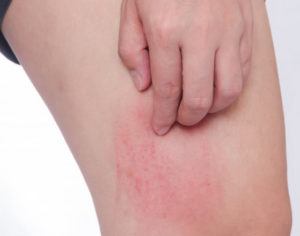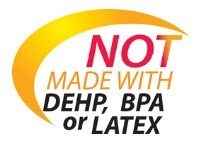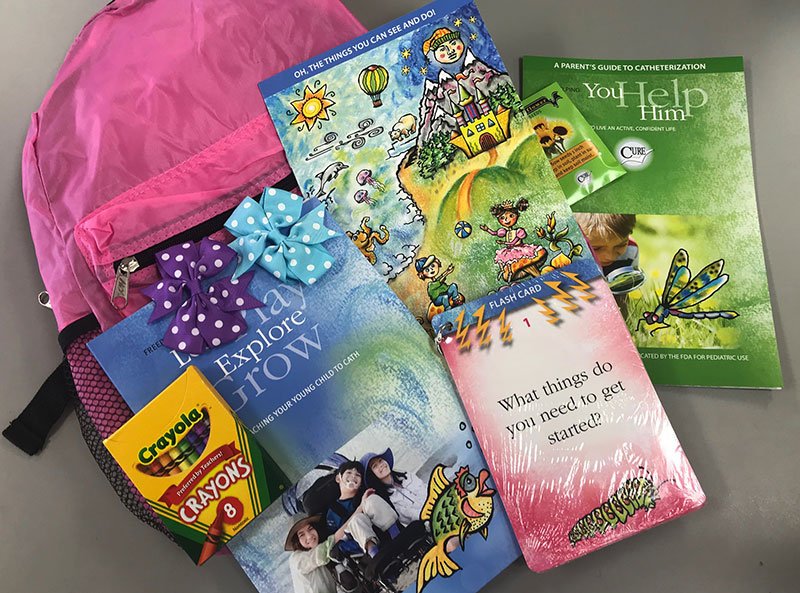 For the general population, latex allergies are uncommon and not something most people have to worry about. In fact, the Asthma and Allergy Foundation of America (AAFA) reports that less than 1% of people are sensitive to natural rubber latex.
For the general population, latex allergies are uncommon and not something most people have to worry about. In fact, the Asthma and Allergy Foundation of America (AAFA) reports that less than 1% of people are sensitive to natural rubber latex.
However, those that have spent a lot time around hospitals – such as people with disabilities and chronic health conditions, as well as healthcare professionals – are at a much higher risk. And, people with Spina Bifida are at the top of the list.
“The highest risk [for latex allergy] is in children with Spina Bifida. More than three out of every five children with Spina Bifida are allergic to latex.” -AAFA
![The highest risk [for latex allergy] is in children with Spina Bifida. More than three out of every five children with Spina Bifida are allergic to latex.](https://curemedical.com/wp-content/uploads/2018/01/sb-education-days.jpg) Did you know that if you have a latex allergy, you may also be severely allergic to foods like bananas and kiwis too? See the full food list below.
Did you know that if you have a latex allergy, you may also be severely allergic to foods like bananas and kiwis too? See the full food list below.
The Scoop on Latex Allergies
So, why are people with Spina Bifida at such a high risk for latex allergies? It has to do with overexposure to latex proteins in Natural Rubber Latex, according to the Spina Bifida Association (SBA), especially “softer rubber dipped products that have been processed longer (like [medical examination] gloves and balloons).”
“People who have Spina Bifida and catheterize; or have several surgeries from very early in life, such as bladder surgery or shunt revisions, are at very high risk for allergy because of a ‘cumulative’ effect over time.” -SBA
Individuals who have a latex sensitivity can have reactions ranging from mild to severe, and evidence suggests that the allergy worsens with continued exposure. Some individuals can experience issues if they breathe in latex fibers and others are just sensitive to skin contact, resulting in a rash or itchiness.
Common products that can contain varying levels of natural rubber latex are:
- rubber bands
- condoms and diaphragms
- rubber household gloves
- rubber balls and toys
- bandages
- elastic in underwear
- syringes
- stethoscopes
- athletic shoes
- tires
- baby bottles, nipples and pacifiers
- poinsettia flowers (only the milky substance inside flower petals and leaves)

It’s true. If you have Spina Bifida, you might have an allergic reaction to poinsettias. These beautiful flowers are also toxic for cats and dogs.
How can you find out if a product contains natural rubber latex?
Suzanne McKee, RN, BSN, Care Coordinator for the Spina Bifida Program at Arnold Palmer Medical Center in Orlando, offers some guidance, “Contacting the manufacturer for product content information is relatively easy via the internet. Remember that all medical products/devices must be labelled if they contain natural rubber latex. This was mandated by the FDA in the late ‘90s.”
“Vaccines and immunizations are potential sources of latex exposure if the syringes or rubber stoppers in vials contain natural rubber latex. The CDC, Centers for Disease Control, has a list of all vaccines and whether they contain latex or not. Try to choose vaccines that are latex-free.”
In situations where there are no latex-free options, the CDC states that the vaccine may be given if a person has not had a severe (anaphylactic) reaction to latex. If a person has had an anaphylactic reaction, the benefits and risks must be weighed and if the benefits outweigh the risks, the vaccine can be given with the following cautions: the provider should be prepared to treat patients who are having an allergic reaction.”
It’s important to differentiate, though, that not all latex products cause reactions. Synthetic latex, such as what’s found in latex paint, does not trigger the symptoms of natural rubber latex allergy.

Bananas and kiwis may cause an allergic reaction in people who have Spina Bifida. Who knew?
Foods that May Cause Allergic Reactions for People Who Have Spina Bifida
Suzanne McKee goes on to explain that “Confusion often exists about latex allergy and cross-reactions with some food and plant proteins. The proteins in natural rubber latex are the “culprits” in causing an allergic reaction and some foods/plants have proteins that the body may react to in similar fashion.”
“Bananas, kiwi, chestnuts and avocados are the most likely to have some cross-reactions. If a person has had a severe reaction to latex, he would be more likely to have a possible cross-reaction to other similar proteins.”
“In general, however, we do not advise our patients to avoid these foods but rather to be aware and educate themselves should a reaction occur. This goes back to the original standard of care that the persons at risk should avoid direct contact with latex as much as possible to avoid building up sensitivities that could precipitate an allergic reaction.”
 According to LatexAllergyResources.org, these are the foods to keep an eye out for:
According to LatexAllergyResources.org, these are the foods to keep an eye out for:
High: Avocado, Banana, Chestnut, Kiwi
Moderate: Apple, Carrot, Celery, Melons, Papaya, Potato, Tomato
Low/Undetermined: Apricot, Buckwheat, Cassava/Manioc, Castor bean, Cherry, Chick pea, Citrus fruits, Coconut, Cucumber, Dill, Eggplant/Aubergine, Fig, Goji berry/Wolfberry, Grape, Hazelnut, Indian jujube, Jackfruit, Lychee, Mango, Nectarine, Oregano, Passion-fruit, Peach, Peanut, Pear, Peppers (Cayenne, Sweet/bell), Persimmon, Pineapple, Pumpkin, Rye, Sage, Strawberry, Shellfish, Soybean, Sunflower seed, Tobacco, Turnip, Walnut, Wheat, Zucchini
Know the Symptoms of spina bifida allergies
Even after a latex allergy has been confirmed, the symptoms and reactions to different products or foods can vary significantly between individuals – even those that are related. Michelle Blazzard of Nevada is the mother of two daughters with Spina Bifida and serves on the board for the Intermountain Region chapter of the SBA.
“My girls get hives when they come in contact with latex. The first time I noticed it was when both girls hit about 4, when in the hospital a rash appeared where the IV tape was. But only one of my daughters, Robbi, is allergic to bananas and she just gets an itchy throat,” Michelle shares.
Michelle Blazzard keeps a close eye on her two daughters who have Spina Bifida because of their allergies to latex and some foods.
If you or someone you care for is allergic to latex, it’s important to know the possible symptoms, should they occur. The SBA shares these common symptoms to be aware of:
 Itching
Itching- Skin redness, hives or rash
- Sneezing
- Runny nose
- Itchy, watery eyes
- Scratchy, hoarse throat
- Cough
- Wheezing and shortness of breath (asthma)
“The most serious allergic reaction to latex is anaphylaxis, a type of shock. An anaphylactic response to latex is a medical emergency.”
Choose a Catheter That Is Not Made With Latex or Scary Chemicals
 Besides natural rubber latex, are you aware of what chemicals may be in the catheters that you or your loved ones use?
Besides natural rubber latex, are you aware of what chemicals may be in the catheters that you or your loved ones use?
The sterile, single use, Pediatric Hydrophilic Cure Catheter® is not made with any scary chemicals like DEHP, BPA or Natural Rubber Latex.
Designed especially for kids and their concerned parents, this easy-to-use, water-lubricated catheter is not made with any scary chemicals like DEHP, BPA or natural rubber latex. Try the Pediatric Hydrophilic Cure Catheter today. Designed especially for kids and their concerned parents, this easy-to-use, water-lubricated catheter is not made with any scary chemicals like DEHP, BPA or natural rubber latex.
Designed especially for kids and their concerned parents, this easy-to-use, water-lubricated catheter is not made with any scary chemicals like DEHP, BPA or natural rubber latex.
This sterile, single-use hydrophilic catheter features polished eyelets with an straight tip. It is offered in 4 French sizes for use by boys and girls.
Video: Try the Pediatric Hydrophilic Cure Catheter®
 To request free samples of the Pediatric Hydrophilic Cure Catheter® or any Cure Medical catheter, contact your local distributor of quality healthcare products, or click here.
To request free samples of the Pediatric Hydrophilic Cure Catheter® or any Cure Medical catheter, contact your local distributor of quality healthcare products, or click here.
Free Educational Resources and supplies Backpack for Your Child
Cure Medical also offers free educational materials to help teach your child how to self-cath, along with complimentary backpacks to carry their urological supplies.
Request your free kids’ backpack here.
*For U.S. + Canada Residents only
Get Involved With Your Local SBA Chapter
 To learn more about latex allergies and how they impact the Spina Bifida community, keep these two resources handy: Spina Bifida Association (www.spinabifidaassociation.org) and Allergy and Asthma Network (www.allergyasthmanetwork.org).
To learn more about latex allergies and how they impact the Spina Bifida community, keep these two resources handy: Spina Bifida Association (www.spinabifidaassociation.org) and Allergy and Asthma Network (www.allergyasthmanetwork.org).
The Spina Bifida Association provides many of its direct services through a nationwide network of Chapters and support groups. Chapters provide public and professional education, information, and support on a community level.
Please contact the Chapter closest to you for more information on what is provided in your area. If there is no Chapter located in your area, please contact sbaa@sbaa.org, or call 800-621-3141, ext. 35.
Note: This information is not meant to be construed as medical advice. Contact your physician with questions related to Spina Bifida and allergies.
Enjoy Our Free Resources & Articles
 CURE NATION is designed with you in mind, to offer assistance and education when you need it through a personal support program.
CURE NATION is designed with you in mind, to offer assistance and education when you need it through a personal support program.
All of the information you find below and on our related social media pages is meant to guide you to places, topics, and resources that enhance your life, while also connecting you with a growing group of friends.
- Sign up for our free, CURE NATION e-newsletter to have our latest stories delivered directly to you, once a month.
- Get our FREE LIFESTYLE + TRAVEL BOOKS here.
- Have an idea you’d like to share? Let us know.
- Be sure to take a minute to meet our Cure Advocates too.
You may also enjoy:


